
Previous Articles 7
Below are selected articles published on this site July - October 2010. We hope you will find some of interest.
Articles here have been moved from our Recent Articles & Announcements page and are in reverse chronological order.
Friday 29 October 2010
Clocks - going back in time...
Here in the UK, the change from British Summer Time back to GMT is our cue to feature some Carlton Heraldic China models of clock towers.
They were made in the early 1900s. From the same period, we show postcards of the architectural gems on which they were based. It is possible that the modellers of the structures worked from similar postcards, which would have been a quick and inexpensive way of seeing the landmarks. Generally, clock towers were paid for by public subscription or local benefactors. Most survive.
They were made in the early 1900s. From the same period, we show postcards of the architectural gems on which they were based. It is possible that the modellers of the structures worked from similar postcards, which would have been a quick and inexpensive way of seeing the landmarks. Generally, clock towers were paid for by public subscription or local benefactors. Most survive.
Torquay - Mallock Clock Tower.
Completed in 1902. This postcard also shows a steam bus.
Completed in 1902. This postcard also shows a steam bus.
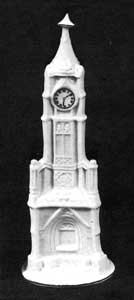
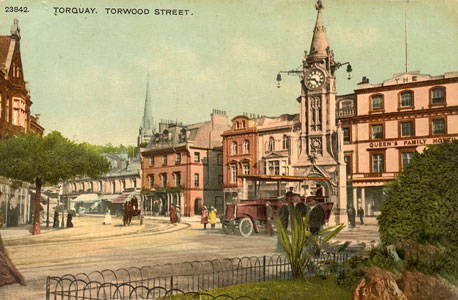
Hastings - Prince Albert Memorial Clock Tower.
Completed in 1864. Demolished in the 1970s. Vandalism was the excuse!
Completed in 1864. Demolished in the 1970s. Vandalism was the excuse!
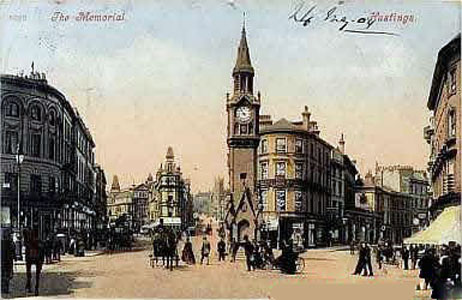
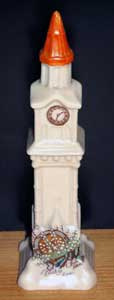
Skegness Clock Tower.
Completed in 1899. Bracing the air!
Completed in 1899. Bracing the air!
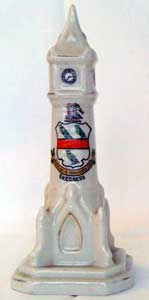
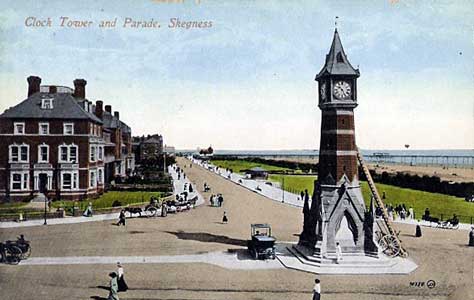
Margate Clock Tower.
Completed in 1889 to mark Queen Victoria's Golden Jubilee of 1887.
The tower is highly elaborate and in the French Renaissance style.
Completed in 1889 to mark Queen Victoria's Golden Jubilee of 1887.
The tower is highly elaborate and in the French Renaissance style.
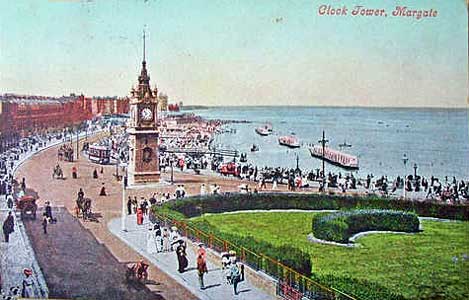
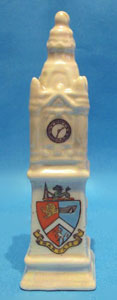
Douglas - Jubliee Clock
Donated by G.W.Dumbell in 1887 to commemorate Queen Victoria's Golden Jubilee.
Made from cast iron.
Donated by G.W.Dumbell in 1887 to commemorate Queen Victoria's Golden Jubilee.
Made from cast iron.
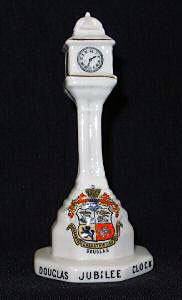
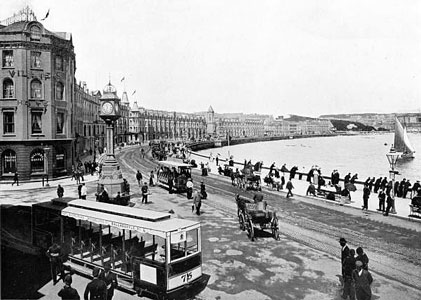
Morecambe Clock Tower
Completed in 1905. Presented to the town by J R Birkett, Mayor and 'Cressey & Keighley, Architects'.
Completed in 1905. Presented to the town by J R Birkett, Mayor and 'Cressey & Keighley, Architects'.

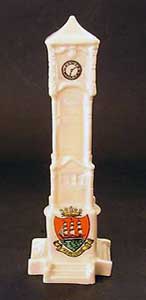
Belfast - Albert Memorial Clock Tower.
Completed in 1869 and by prolific Irish architect W.J.Barrie, the memorial was built in a mixture of French and Italian Gothic styles. It was dubbed Belfast's answer to the Leaning Tower of Pisa, but the four feet off the perpendicular has now been corrected. The lean is apparent in the postcard from the early 1900s - notice even then that two number 37s have come at the same time, despite being horse drawn!
Completed in 1869 and by prolific Irish architect W.J.Barrie, the memorial was built in a mixture of French and Italian Gothic styles. It was dubbed Belfast's answer to the Leaning Tower of Pisa, but the four feet off the perpendicular has now been corrected. The lean is apparent in the postcard from the early 1900s - notice even then that two number 37s have come at the same time, despite being horse drawn!
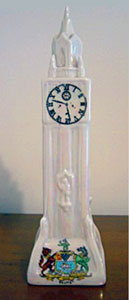
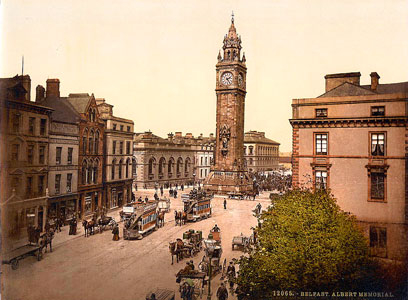
To date, eleven Carlton Heraldic China models of clock towers have been identified.
Aside from the seven shown here, the others are Ayr Clock Tower, Downham Clock Tower and Keswick Town Hall & Clock Tower. A "generic, all purpose" clock tower also appears to have been made, similar to the Hastings model, inappropriately printed with various town names.
Carlton Ware was one of the first potteries to follow WH Goss's lead in producing souvenirs bearing crests. Carlton Heraldic China was very popular and remained in production for more than 25 years. It would have generated considerable income for the pottery. ❑ © HP 2010
Aside from the seven shown here, the others are Ayr Clock Tower, Downham Clock Tower and Keswick Town Hall & Clock Tower. A "generic, all purpose" clock tower also appears to have been made, similar to the Hastings model, inappropriately printed with various town names.
Carlton Ware was one of the first potteries to follow WH Goss's lead in producing souvenirs bearing crests. Carlton Heraldic China was very popular and remained in production for more than 25 years. It would have generated considerable income for the pottery. ❑ © HP 2010
Scroll down for more.
Wednesday 20 October 2010
Confederation jug - old, new(ish) or fake?

Like most potteries, Carlton Ware produced many Commemorative items, the earliest known being those of the Boer War 1899-1902. Such things generated good and necessary income for potters.
One of these, the Confederation Jug shown right, was produced in 1937. This celebrated the 70th anniversary of the 1867 Confederation of Canada, then comprising only four of the ten eventual provinces. The jug was large and elaborately embossed, as well as being highly decorated. It was made in a limited edition of 350, each being supplied with a circular plaque, repeating the number of issue.
Seventy years seems an odd anniversary to celebrate, but that for the fiftieth was quashed by World War One. The impetus for Carlton Ware to commemorate the 70th was no doubt the Coronation of King George and Queen Elizabeth, also in 1937.
One of these, the Confederation Jug shown right, was produced in 1937. This celebrated the 70th anniversary of the 1867 Confederation of Canada, then comprising only four of the ten eventual provinces. The jug was large and elaborately embossed, as well as being highly decorated. It was made in a limited edition of 350, each being supplied with a circular plaque, repeating the number of issue.
Seventy years seems an odd anniversary to celebrate, but that for the fiftieth was quashed by World War One. The impetus for Carlton Ware to commemorate the 70th was no doubt the Coronation of King George and Queen Elizabeth, also in 1937.

Clearly, Carlton Ware had a keen eye on its overseas markets, in this case Canada. The jugs must have been very expensive to produce and it is possible that the limited edition may not have reached its intended edition of 350.
The impetus for this article was an undecorated version of the jug that appeared for sale on eBay. In September, the seller took it to the Antiques Roadshow to try to find more about it.
The experts suggested that the jug was either a prototype or unfinished. Unfinished it certainly is, but there are other possibilities.
The impetus for this article was an undecorated version of the jug that appeared for sale on eBay. In September, the seller took it to the Antiques Roadshow to try to find more about it.
The experts suggested that the jug was either a prototype or unfinished. Unfinished it certainly is, but there are other possibilities.
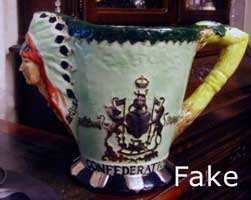
About fifteen years ago fake versions of the jugs started to appear. These were decorated in a very inferior way, as shown on the right. Obviously, an original mould survived the liquidation of the Copeland Street works in 1989. The plain jug could be from the faker's stable, though it has no backstamp.
The jug has been dipped into what is called a honey glaze. As far as is known, Carlton Ware did not use this utilitarian glaze until the Woods took over the pottery in 1968. This suggests it is more recently made than those from 1937. The absence of a backstamp also points to it having been made elsewhere from a surviving mould, after 1989.
© Harvey Pettit 2010
Thanks to eBay seller driverjohnfootball for use of the image of the honey glaze jug.
The jug has been dipped into what is called a honey glaze. As far as is known, Carlton Ware did not use this utilitarian glaze until the Woods took over the pottery in 1968. This suggests it is more recently made than those from 1937. The absence of a backstamp also points to it having been made elsewhere from a surviving mould, after 1989.
© Harvey Pettit 2010
Thanks to eBay seller driverjohnfootball for use of the image of the honey glaze jug.
Scroll down for more.
Monday 4 October 2010
Imari & Carlton Ware
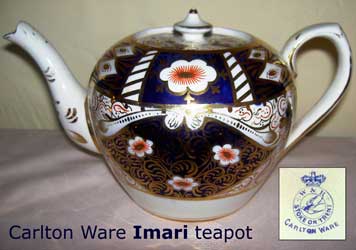
Japanese Imari wares, and the countless European copies or interpretations of them, are bold and ostentatious, characterized by dense patterns. Typically, the Imari palette includes underglaze blue, iron-red enamel and gold.
Mike Maunder, whose main interest is in early ware and especially Blushware, sent us the picture of the early Carlton Ware teapot on the right. It is clearly in the Imari style and consequently this pattern has come to be called Imari in Carlton Ware circles. The pot has the blue crown mark.
Mike Maunder, whose main interest is in early ware and especially Blushware, sent us the picture of the early Carlton Ware teapot on the right. It is clearly in the Imari style and consequently this pattern has come to be called Imari in Carlton Ware circles. The pot has the blue crown mark.
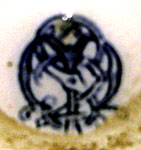
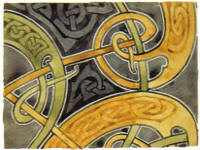
Alongside the blue crown mark, which indicates a pre 1920 date, the teapot has the curious mark shown on the left. Its sinuous form suggests a date of around 1900; it has similarities with Celtic inspired decorations fashionable at the time as illustrated by the drawing on the right by Archibald Knox. But what is this mark, Mike asks?
The mark is not as clear as it might be and is a mystery. Could it be a stylised monogram formed from intertwined letters, perhaps belonging to a retailer? Its style has no association with the pattern, so does not suggest a link to Imari style wares. Surely, it is not another maker's mark? If you have any thoughts, or have come across this mark before, let us know.
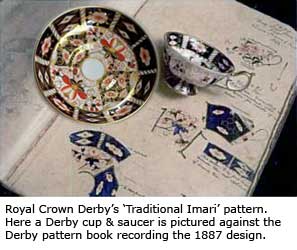
Carlton Ware copied its Imari pattern from Royal Crown Derby, which in its history produced over 3000 Imari type patterns.
The evidence for this can be found in Margaret Sergeant's book Royal Crown Derby, which shows a page from a Derby pattern book with the same pattern pictured alongside a Derby cup and saucer. Derby introduced it in 1887. Derby collectors call it "Traditional Imari" and
it was extensively copied, even by Wedgwood.
This pattern remains in production today at Royal Crown Derby, which is again an independent and privately owned pottery after a family buy out in 2000.
The evidence for this can be found in Margaret Sergeant's book Royal Crown Derby, which shows a page from a Derby pattern book with the same pattern pictured alongside a Derby cup and saucer. Derby introduced it in 1887. Derby collectors call it "Traditional Imari" and
it was extensively copied, even by Wedgwood.
This pattern remains in production today at Royal Crown Derby, which is again an independent and privately owned pottery after a family buy out in 2000.
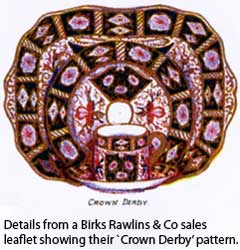
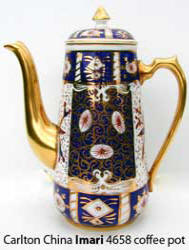
The Derby pattern was also copied by Birks Rawlins & Co, (BR & Co), whose Vine Street works Cuthbert Wiltshaw bought in 1928. The pattern was continued by Carlton China during W&R's short ownership of the BR & Co's china works.
BR & Co acknowledged the source of its version by calling it 'Crown Derby' in sales literature, as we show on the left.
BR & Co acknowledged the source of its version by calling it 'Crown Derby' in sales literature, as we show on the left.
Carlton Ware used the Imari palette of underglaze blue, iron-red enamel and gold on other patterns. Below we show Arita 1727, Marguerite 1655, Imari Flowers & Leaves (pattern number unknown) and Christmas Cactus 1646 (a variant of this Blushware pattern).
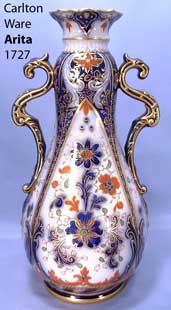
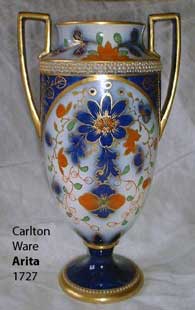
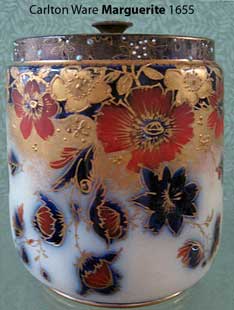
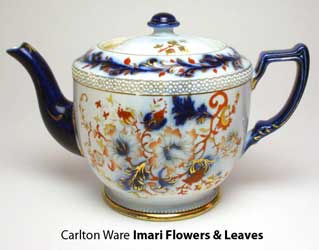

No doubt, with the passage of time, more will be discovered. © Harvey Pettit 2010
I would like to thank Mike Maunder, Margaret Sergeant, Peter Goodfellow and MoDA, the Museum of Domestic Design & Architecture for use of images and The Cochrane and Pettit Archive of Carlton Ware for use of its research material.
Scroll down for more.
Monday 27 September 2010
Spot the difference
Bruce Nichol sent us the pictures below, suggesting that the vase on the left with the powder blue ground is decorated with a different pattern from the others shown.
The obvious differences are the ground colours and the colours of the raised enamelling that each employs but these alone would not make them different patterns but just variants of the same pattern.
Are there other differences that make them different patterns?
The obvious differences are the ground colours and the colours of the raised enamelling that each employs but these alone would not make them different patterns but just variants of the same pattern.
Are there other differences that make them different patterns?
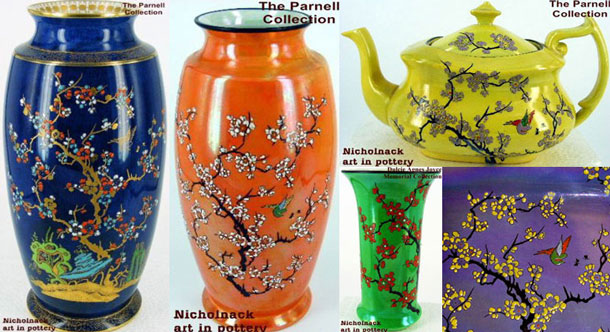
The answer is yes and no! Read on....
PRUNUS versus PRUNUS SPRAY
So, what are the differences between the powder blue example and the other similar looking pots that Bruce asks about? Are their patterns different?
PRUNUS
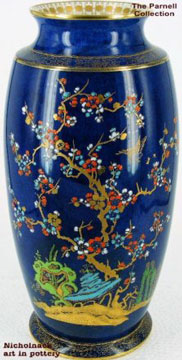
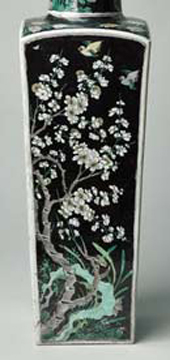
In ceramic circles, the pattern on the powder blue vase is known as PRUNUS and indeed this is what it was called at the pottery, this variant having pattern number 2428.
PRUNUS was introduced by Horace Wain, shortly after his arrival at Copland Street c1912. The source of many of his patterns is to be found on Chinese porcelain and this is a good example.
A vase in the Chinese collection at the Lady Lever Art Gallery in Liverpool illustrates the influence. On the right, we show one of the sides of this square vase that depicts prunus blossom emerging from rocks and with birds fluttering amongst the branches of the tree. It was made during the Kang Hsi period (1662-1772). Such Chinese export porcelain influenced many British potteries, notably Worcester, Bow and Chelsea.
PRUNUS was introduced by Horace Wain, shortly after his arrival at Copland Street c1912. The source of many of his patterns is to be found on Chinese porcelain and this is a good example.
A vase in the Chinese collection at the Lady Lever Art Gallery in Liverpool illustrates the influence. On the right, we show one of the sides of this square vase that depicts prunus blossom emerging from rocks and with birds fluttering amongst the branches of the tree. It was made during the Kang Hsi period (1662-1772). Such Chinese export porcelain influenced many British potteries, notably Worcester, Bow and Chelsea.
All of the Carlton Ware examples below are printed from the same copper plate, so effectively they are the same pattern. The powder blue example, however, uses all of the pattern print, which includes the rocks from which the prunus tree emerges. The rocks are missing from the other examples and this is the only difference, apart from colours used and the colour of the print - on the powder blue example the pattern is printed in gold, on the others the pattern is printed in black.

In all cases, even the little bird is present; it is painted suitably to contrast with the ground colour. On the powder blue example it is just printed in gold.

Notice the tiny butterflies that have caught the bird's attention! It looks as though our feathered friend is about to have lunch.
PRUNUS SPRAY
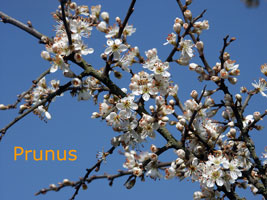
For those patterns that did not include the rocks from which the tree springs, Carlton Ware adopted the pattern name of PRUNUS SPRAY. Hence our yes and no answer to Bruce's query about whether or not the patterns are the same.
PRUNUS SPRAY is a simplified version of PRUNUS. The exclusion of the elaborate rocks meant that it was less costly to decorate and thus could be sold for less. It was a successful pattern having many variants being offered in many different coloured grounds.
PRUNUS SPRAY is a simplified version of PRUNUS. The exclusion of the elaborate rocks meant that it was less costly to decorate and thus could be sold for less. It was a successful pattern having many variants being offered in many different coloured grounds.
At a later date Carlton Ware introduced a more modern version of the pattern called NEW PRUNUS and another traditional version called PRUNUS BLOSSOM, but these are other stories. © Harvey Pettit 2010.
NOTE - In some publications, erroneously, PRUNUS SPRAY is called Orange Blossom.
Following our usual convention, factory given names are shown in BOLD UPPERCASE, whereas names given by the long-standing Carlton Ware World naming committee are shown in Bold Capitalised Lowercase.
Information in this article is sourced from The Cochrane & Pettit Archive of Carlton Ware.
We would like to thank Bruce Nichol, The Parnell Collection, The Dulcie Agnes Joyce Memorial Collection and the Lady Lever Art Gallery for the use of images.
NOTE - In some publications, erroneously, PRUNUS SPRAY is called Orange Blossom.
Following our usual convention, factory given names are shown in BOLD UPPERCASE, whereas names given by the long-standing Carlton Ware World naming committee are shown in Bold Capitalised Lowercase.
Information in this article is sourced from The Cochrane & Pettit Archive of Carlton Ware.
We would like to thank Bruce Nichol, The Parnell Collection, The Dulcie Agnes Joyce Memorial Collection and the Lady Lever Art Gallery for the use of images.
Scroll down for more.
Friday 30 July 2010
What a Relief!
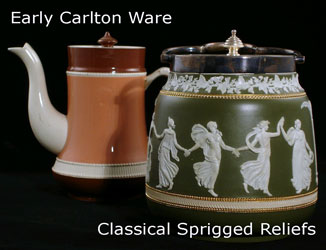
Some of the earliest Carlton Ware used sprigged reliefs as decoration. A good example is the sage green stoneware biscuit barrel on the left. The bas-relief figures of classical maidens and the border of ivy leaves on the shoulder of the barrel are typical sprigs. These were made from clay pressed into separate moulds like the one below.
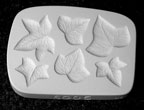
They were then peeled from the mould and applied with slip (liquid clay) to the body of the pot to be decorated.

They were then peeled from the mould and applied with slip (liquid clay) to the body of the pot to be decorated.
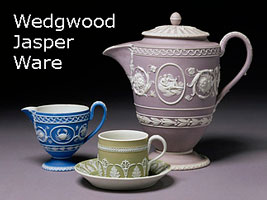
The technique of sprigging on pots has been used through the ages; rightly or wrongly, this type of decoration is sometimes referred to as Jasper Ware after the fine grained stoneware introduced by Josiah Wedgwood about 1775. Jasper, a white mineral, was the name given to the fine white body devised by Josiah. Subsequent to Wedgwood's introduction of his cameo-like decorations many other manufactories introduced pottery of like appearance. More accurately, some would be better called sprigged wares because a Jasper-like body was not used and indeed this is what we call Carlton Ware's versions - a selection is shown below.
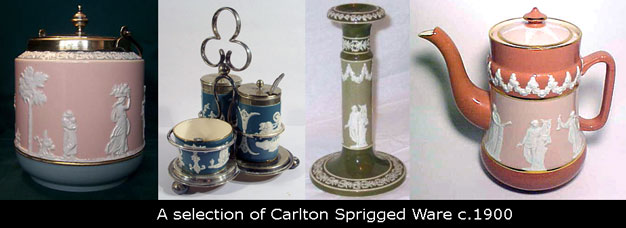
The Carlton Ware examples shown above are made from earthenware, which of necessity has to be glazed to protect the porous body. As a consequence, some of the fine detail of the sprigged reliefs is lost because the glaze smoothes over their crisp edges, so it does not bear close comparison with Wedgwood's Jasper Ware; as a stoneware-like and vitrified body this was not porous and remained unglazed, allowing the sharpness of the sprigs to remain.
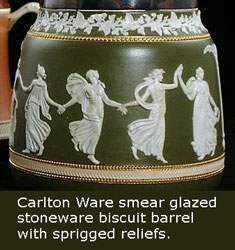


In its early days, Wiltshaw & Robinson fulfilled the need for less expensive Jasper Ware lookalikes, which no doubt appealed to the aspiring middle classes of the day.
W&R did, however, offer sprigged decorations using a vitrified stoneware body, which was smear glazed.
This thinnest of coatings gave the body and its sprigged reliefs a satin sheen and at the same time retained much of the crispness of the sprigging. Stoneware examples are much harder to find, suggesting they were not as popular as their earthenware counterparts, probably because these were somewhat more expensive.
The stoneware body has to be that used for the large number of match holder/strikers made by the pottery, many of which were crested, especially for Oxford & Cambridge colleges. A selection is shown below.
W&R did, however, offer sprigged decorations using a vitrified stoneware body, which was smear glazed.
This thinnest of coatings gave the body and its sprigged reliefs a satin sheen and at the same time retained much of the crispness of the sprigging. Stoneware examples are much harder to find, suggesting they were not as popular as their earthenware counterparts, probably because these were somewhat more expensive.
The stoneware body has to be that used for the large number of match holder/strikers made by the pottery, many of which were crested, especially for Oxford & Cambridge colleges. A selection is shown below.

Sprigged Wares must have played an important part of the output of the then newly formed Copeland Street pottery, helping to establish the reputation of Wiltshaw & Robinson's Carlton Ware. As always, there is more than first meets the eye with our favourite pots.
© Harvey Pettit 2010
In the Summer of 1999, Helen Martin and Angela Dixon wrote an excellent four page article on Carlton Sprigged Ware for The Carlton Times. We provide a good quality facsimile of this article, which you can view by clicking here. The file size is 600KB and it will open in a new window. We would like to thank Helen Martin for permission to reproduce this excellent and well-researched article.
© Harvey Pettit 2010
In the Summer of 1999, Helen Martin and Angela Dixon wrote an excellent four page article on Carlton Sprigged Ware for The Carlton Times. We provide a good quality facsimile of this article, which you can view by clicking here. The file size is 600KB and it will open in a new window. We would like to thank Helen Martin for permission to reproduce this excellent and well-researched article.
Carlton Ware World © Copyright 2010. All rights reserved.

